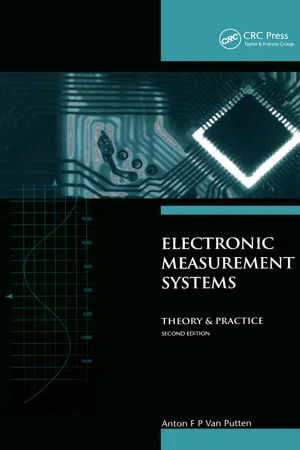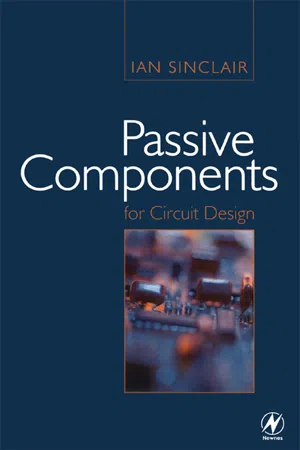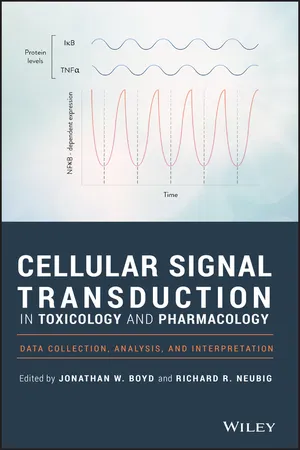Physics
Transduction
Transduction refers to the process of converting one form of energy into another. In physics, it often involves the conversion of physical quantities, such as sound or light, into electrical signals. This process is essential in various devices, including sensors, transducers, and communication systems, where the conversion of energy from one form to another is crucial for their operation.
Written by Perlego with AI-assistance
4 Key excerpts on "Transduction"
- eBook - ePub
Electronic Measurement Systems
Theory and Practice
- A.F.P van Putten(Author)
- 2019(Publication Date)
- CRC Press(Publisher)
We will discuss such developments as those in microsensors, smart sensors, micromachining, packaging of sensors and technologies. Also, optoelectronics and some basic interfacing circuits for sensors will be discussed. It can be concluded that we still are at the beginning of a tremendous area of possibilities which will result in completely integrated single-chip microsystems able to perform different kind of task.To avoid any confusion we will start by presenting the required definitions and terminology used.6.2CLASSIFICATION OF TRANSDUCERSGenerally speaking the word ‘transducer’ can be thought to be derived from the Latin verb traducere which means ‘to convert’. So a transducer can be defined as a device capable of converting energy from one form into another. Transducers can be found both at the input as well as at the output stage of a measuring system. The word transducers can be considered as a collective noun. The input transducer is called the sensor, because it senses the desired physical quantity and converts it into another energy form. The output transducer is called the actuator, because it converts the energy into a form to which another independent system can react, whether it is a biological system or a technical system. So, for a biological system the actuator can be a numerical display or a loudspeaker to which the visual or aural senses react respectively. For a technical system the actuator could be a recorder or a laser, producing holes in a ceramic material. The results can be interpreted by humans.Figure 6.2The six different energy domains at the input of a measuring system.6.2.1Types of energy formWe can distinguish six different energy domains: (1) radiant, (2) mechanical, (3) thermal, (4) electrical, (5) magnetic and (6) chemical. If certain information is already available in the electrical domain it can be claimed that it requires no energy conversion, but in general there is ‘shape’ conversion left and this is just the domain which belongs to the field of electronics and electrical science and engineering. A good example of such a sensor only sensitive to electrical energy is the probe of an oscilloscope, with which a good adaptation to the signal source is realized. In the modifier stage we meet other examples of shape converters, for instance the A/D and D/A converters. If only the identification unit of figure 6.1 is considered we can draw figure 6.2 in which the possible energy conversions at the input are depicted schematically. In the same way, the six different domain conversions at the output can be drawn. This is illustrated in figure 6.3 , where compared with figure 6.2 - eBook - ePub
- Ian Sinclair(Author)
- 2000(Publication Date)
- Newnes(Publisher)
Chapter 8Transducing components
A transducer is a device that converts energy from one form into another and in the broadest sense even a resistor qualifies for this description since it converts electrical energy into heat energy. We normally reserve the term of transducer, however, for the components in which the conversion is desired and used, and in this book we are concerned only with passive transducers that require no energy supply other than the energy that is being converted. Many of these devices are specialized, and only a broad outline of some of the most common devices will be dealt with in this book for reasons of space. The reader should consult a more specialized text for further information.The main features of transducers, as far as their status as passive components is concerned, are their sensitivity or efficiency, their electrical impedance, their linearity and their bandwidth or frequency response. Sensitivity or efficiency refers to the fraction of input energy which is converted to output energy, and for many transducers this can be very low, of the order of a few per cent. The percentage efficiency is often masked by quoting the sensitivity in terms of the amount of output per unit input. Since the units of input and output will not necessarily be the same, the efficiency of conversion is not obvious.The electrical impedance of transducers can range from a fraction of an ohm to many megohms, and it affects the type of connections that can be made to the transducer. In addition, if the transducer has an electrical output, the impedance level usually goes hand in hand with the typical electrical output level. Linearity means the extent to which the output is proportional to the input, so that a perfectly linear device would have a graph of output plotted against input that would be a straight line.Some of the earliest transducers to be used in electronics were the electro-acoustical type, microphones and loudspeakers. A sound wave is the waveform caused by a vibration which will, in turn, cause an identical vibration to be set up in any material affected by the sound wave. The transducer for sound energy to electrical energy is the microphone, and microphone types are classified by the type of transducer they use. The characteristics of a microphone are both acoustic and electrical. The overall sensitivity is expressed as millivolts or microvolts of electrical output per unit intensity of sound wave, or in terms of the acceleration produced by the sound wave. In addition, though, the impedance of the microphone is of considerable importance. A microphone with high impedance usually has a fairly high electrical output, but the high impedance makes it very susceptible to hum pickup, either magnetically or electrostatically coupled. A low impedance is usually associated with very low output, but, provided that the layout and shielding are both good, hum pickup is almost negligible. - eBook - ePub
Cellular Neurophysiology and Integration
An Interpretive Introduction
- W. R. Uttal(Author)
- 2014(Publication Date)
- Psychology Press(Publisher)
6 Cellular Aspects of the Transduction Process * A. Introduction Transduction, the process by which environmental stimuli are converted into neural signals, is a multistage process with important steps occurring at both the macroscopic and cellular levels. Before the actual conversion of energies (and energy conversion is the essential feature of Transduction), each of the receptor organs carries out some nonneural or preneural modification of the incoming stimulus. The eye, for example, modulates the intensity of a photic stimulus by varying the pupil size. It also filters the light, since some wavelengths are selectively absorbed by the ocular media. Preneural modifications also occur in the mechanical receptors. The ear modulates auditory stimulus intensity by means of a system of membranes, muscles, and levers. Far more important, however, is the preneural conversion of the temporal patterns of acoustic energy to mechanical spatial patterns as a function of the hydrodynamics of the cochlea. This important alteration of dimensions is carried out on an entirely mechanical and totally nonneural basis. Complex as these preneural modifications of the stimulus may be, they are not “neurophysiological” in the sense defined in this book. Only after a stimulus falls on a receptor and its physical energy is converted to the electrochemical energy of the cell do the real neurophysiological processes begin. The Transduction of physical to electrochemical energies that occurs within the receptor cell also consists of a number of distinct and separable processes. The primary sensory action may be defined as the specific interaction between the stimulus energy and some part of the receptor that triggers the actual energy conversion. From a certain perspective, the primary sensory action may also be considered to be a preneural process rather than a neural process itself - eBook - ePub
Cellular Signal Transduction in Toxicology and Pharmacology
Data Collection, Analysis, and Interpretation
- Jonathan W. Boyd, Richard R. Neubig, Jonathan W. Boyd, Richard R. Neubig(Authors)
- 2019(Publication Date)
- Wiley(Publisher)
1 Introduction to Cellular Signal Transduction : The Connection Between a Biological System and Its SurroundingsJonathan W. Boyd1 Department of Orthopaedics and Department of Physiology and Pharmacology, West Virginia University School of Medicine, Morgantown, WV, USA2 Department of Pharmacology and Toxicology, Michigan State University, East Lansing, MI, USA3 Chem Bio & Exposure Sci Team, Pacific Northwest National Laboratory, Richland, WA, USA4 Institute for Microproductions, Leibniz University, Hannover, Germany1, Richard R. Neubig2, Alice Han3, and Maren Prediger4The rate of energy flow governs anabolic processes in chemical and biological systems. When a steady flow of external energy enters into an open system, there is a driving force to assemble mechanisms from available components in order to disperse more energy in the quest for a stationary steady state [1] . The driving force does not distinguish between mechanisms of energy Transduction but favors those that disperse energy more efficiently. The mechanisms that effectively distribute energy become temporal repositories of that energy, which allows other mechanisms (i.e. energy dispersal systems) to tap into them, which further enhances energy dispersal and ultimately creates networks (Figure 1.1 ).Schematic displaying energy dispersion.Figure 1.1A commonplace example of this classic thermodynamic phenomenon is a hot cup of coffee reaching equilibrium with a cooler room temperature; convection waves – in addition to thermal radiation – allow the fastest distribution of energy to the local environment. In regard to ecology, times of plenty can yield massive population increases eager to consume (i.e. distribute) as much energy as possible; finally, in relevance to cellular signal Transduction, many distribution networks are directly linked to energy availability via direct interaction with adenosine triphosphate (ATP). It is important to note, however, that the availability of energy on Earth is not at steady state (e.g. seasons of the year) and, in fact, is kept far from equilibrium [2]
Index pages curate the most relevant extracts from our library of academic textbooks. They’ve been created using an in-house natural language model (NLM), each adding context and meaning to key research topics.
Explore more topic indexes
Explore more topic indexes
1 of 6
Explore more topic indexes
1 of 4



